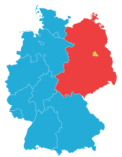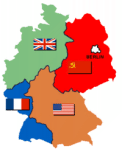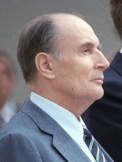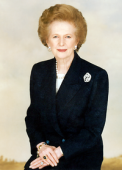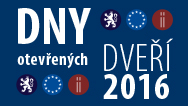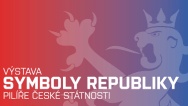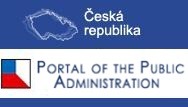Important days
3. 10. 2010
Reunification of Germany 3 October 1990
Political Situation in Europe before the Reunification
Relations between both parts of Germany were very strained during the entire Cold War. However, since the half of 1980’ certain changes in communication between West German and East German politicians began to be apparent. The General Secretary of the Communist Party of the German Democratic Republic (GDR) Erich Honecker accepted, as the first Eastern Europe political representative, invitation to visit the Federal Republic of Germany (FRG) in 1984. The meeting was not held eventually because of deployment of intermediate range ballistic missiles in the FRG. He met Helmut Kohl as late as in 1987 during his visit to the FRG. Both leaders agreed on a "constructive cooperation in spite of different views on crucial issues".
Nevertheless, a decisive factor for the German reunification was the arrival of a new Establishment in the Soviet Union after the appointment of Mikhail Gorbachev to the office of the General Secretary of the Central Committee of the Communist Party of the Soviet Union. In contrast to his predecessors, Gorbačov regarded as necessary to change radically not only the internal economic and political conditions but also the foreign policy of the Soviet Union including the attitude to the East European countries.
On 25 October 1989, during his visit to Finland, Gorbachev officially repudiated the Brezhnev's doctrine and admitted that East European countries had right to make their own policies. The new approach to the existing East European satellites became common under the term Sinatra Doctrine, which was a reminiscence of the lyrics of the Sinatra's song "I do it my way". However, Gorbachev's attitude to the German reunification was radically negative both before 1989 and after the fall of the Berlin Wall.
The first meeting of Mikhail Gorbachev and the Chancellor of the Federal Republic of Germany Helmut Kohl was held on 24 October 1988. At that time Kohl did not believe that he would ever negotiate with Mikhail Gorbachev on the German reunification. When asked about a possibility of Gorbachev offer of reunification of Germany, Kohl replied: "I am not a writer of futuristic novels like Wells. What you ask me about, is rather something of the Empire of Fantasy".
Events after the fall of the Berlin Wall
The crucial role in the process of the German reunification was played by the West German Chancellor Helmut Kohl who, after the fall of the Berlin Wall, clearly declared his intention to reunify both parts of the divided German state. On 28 October he gave in Bundestag an important speech in which he emphasized necessity of a speedy reunification of both German republics. On 28 November 1989 he presented so-called ten-point plan for German reunification.
The most important was the fifth point of the plan in which Helmut Kohl mentioned a possibility to "develop confederate structures between the two states in Germany with the objective of creating of a federal order in Germany".
However the negotiations with East German political representatives were complicated by the fact that the West German side had not known for a long time whom to regard as the legitimate partner at the negotiating table. Officially it was Egon Krenz, the General Secretary of the SED, who was the highest representative of the GDR, but he was holding his post only from 24 October 1989 to 6 December 1989 and thus he was not able to guarantee continuity of the negotiating process.
It was apparent that this issue could be solved only by general elections in the GDR. They were held on 18 March 1990 and the Alliance for Germany, which won more than 47 % of votes, became a straight winner of the elections. Also Kohl’s CDU took part in the elections as a part of this alliance and won more than 40 % of votes. "Not even I had expected such a result" said Helmut Kohl.
The ensuing negotiations on the new cabinet were quite smooth and on 12 April 1990 a new cabinet was appointed. It was headed by Lothar de Maizir (CDU) who negotiated with Helmut Kohl on the future arrangements.
The integration of the two states was done also at the economic level. The date of declaration of the monetary union between the GDR and the FRG was set and the union came into effect on 1 July 1990. On 23 August 1990 the East German parliament (Volkskammer) adopted at its extraordinary session the reunification of both parts of Germany in the ratio of 294 to 64 and on 31 August 1990 the Reunification Treaty was signed by the State Secretary of the GDR Günther Kraus and by the West German Minister of Interior Wolfgang Schäubl. The Treaty contained 45 articles and three annexes. In the Treaty there were defined relations between the two German republics and set down the state division of former GDR to five federal republics governed by the Constitution of the Federal Republic of Germany.
Attitudes of the USA, Soviet Union, France and Great Britain
On 13 November 1989 an important negotiation of the most significant American politicians -President George Bush, the Secretary of State James Baker and the chief expert on foreign policy Henry Kissinger – was held. Henry Kissinger said on the issue of the German reunification: "The German reunification is inevitable and the United States will have to pay for that if Germans feels that we are putting obstacles in their path".
Most of American political representatives connected the support of the German reunification with its membership in NATO. The unity of NATO was more important for the United States than the act of the reunification of both German republics itself. As far as this issue is concerned, Kohl was for the United States a fundamental advocate of their strategy of incorporation of unified Germany into the NATO structures.
A significant event in the process of negotiations on the German reunification was the setting-up of so-called “4+2 mechanism“. This mechanism meant regular meetings of representatives of the Soviet Union, United States, Great Britain, France and both German states. There were certain critical opinions regarding this arrangement. In particular on the American side there were fears of loss of the influence on the situation in Germany because of broadening of negotiating competences to more states.
Mikhail Gorbachev’s approach to the German reunification was always very reserved and he was absolutely unsympathetic to plans for the incorporation of unified Germany to the NATO structures. This issue was very sensitive for Gorbachev because these discussions had begun soon after the breakdown of the Eastern Block.
Gorbachev became more involved in the negotiations on the German reunification at the end of May 1990 when he intensively discussed this issue with his American counterpart George Bush. George Bush together with the Secretary of State James Baker presented during these negotiations their idea on the role of NATO in arrangement in Europe. According to Bush and Baker, NATO intended to play a role of an "anchor of stability" which would guarantee solidarity of Europe with NATO.
Mikhail Gorbachev agreed to this proposal in fact, which meant principal change in the attitude of the Soviet representatives to the issue of reunification. Further important shift in opinion took place during the visit of Helmut Kohl in the Soviet Union in mid-July 1990, after which Gorbachev withdrew his reservations to the planned size of Bundeswehr and the German membership in NATO. Thus, main reservations on the Soviet side to the German reunification were removed.
In France there were strong fears of unification of the two divided German republics. These fears were based on the idea that the strong Germany would have different view of the function of the European Union.
France was afraid of weakening of its influence on the foreign policy of the European Union Also the demographic factor played its important role in this respect. While the FRG had number of inhabitants similar to that of France, the unified Germany would have about 80 million inhabitants. The advisor of the French President Mitterand, Jacques Attali, confidentially told his Soviet counterpart that "France does not wish the reunification of Germany despite its conviction that it is inevitable in the end".
Not even the French President Mitterand concealed his fears of united Germany. As early as in August 1989 began to hold an opinion that in connection with the unification of the two republics the term unification instead of reunification should be used. Mitterand’s fears of a possibility of unification of Germany further increased during 1989. In September, during his visit to Kiev, he declared that excessive haste in connection with the German unification could have negative impact on the stability of the European Community.
His fears of German reunification could not be mitigated even by the fact that Mitterand and Helmut Kohl were tied by a firm bond of friendship. He expressed his feelings on 20 January 1990 when, during a private conversation with the Prime Minister Margaret Thatcher, stated that "reunification of Germany might lead to the birth of a new Hitler and to the revival of memories of bad Germans who ruled over Europe then". In March 1990 the French Ambassador to the United Kingdom during his visit to Margaret Thatcher said that according to the meaning of the French government "France and Great Britain must jointly face to the German threats".
An extremely negative stand to the German reunification was holding by the Prime minister of Great Britain Margaret Thatcher. Unlike other statesmen, she did not regard the German reunification as a historical crowning of the disintegration of the Soviet Block and the unification of divided Europe. She was seeing the process of German reunification from the point of view of her fears of the revision of German frontiers. Her fears increased in December 1989 after the release of ten-point plan of Helmut Kohl; in response to this plan she said: "We have defeated Germans twice and now they are here again".
During her meeting with Helmut Kohl she declared that "it is possible to consider the German reunification of the two republics as late as after some 10 or 15 years when it is undoubted that both countries have sufficiently firm democracy".
She was seeking allies for her approach among European politician and partly found such an ally in the person of François Mitterand who, however, did not held such a strong attitude. Unlike the French President, she did not believe that Germany would restrict its own political and economic ambitions in the framework of the European Community".
She regarded the process of reunification as too fast and improvident. She also feared that the process of reunification would weaken the Gorbachev’s position in the Soviet Union. Immediately after the fall of the Berlin Wall in November 1989, Thatcher informed Mikhail Gorbachev that German reunification was not in the interest of Great Britain.
Nevertheless, the British Prime Minister remained isolated with her flat resistance to the German reunification,. "Margaret Thatcher went too far with her opposition in this matter", said former west German Chancellor Helmut Schmidt.
The attitude of the British Prime Minister changed as late as after the Dublin summit in May 1990; the summit guaranteed existing frontiers on Oder and Neisse. Thus, the ensuing negotiations in the composition 2+4 could be held in a more unemotional spirit. On 12 September 1990 the Treaty on the Final Settlement with Respect to Germany was signed in Moscow. This principal document stipulated the German reunification from the point of view of the international law.
By the adoption of this Treaty, the Allies lost their right and responsibility related to Berlin and Germany as a whole. In the Article 7 it is stipulated that "the united Germany shall have full sovereignty over its internal and external affairs". The Treaty also bound member states to maintain limited number of German armed forces of Germany at the level of 300 000 men. After the signature of this Treaty nothing hampered the German reunification.
German Unity Day
On the night of 2 October to 3 October 1990, more than 100 000 people came to celebrate the reunification of both German states at the Republic Square in Berlin.
As Helmut Kohl highlights in his memoirs, the act of the German reunification at the place in front of the Reichstag building was a historical symbol: "From the window of the western portal, the social democrat Scheidemann declared in November 1918 the First German Republic. Its end was symbolized by flames which flared up out of the cupola of the building in 1933. After the end of the Second World War, Soviets hoisted on its ruins the red flag and started the division of Germany and Europe. What could have been a better place, after those forty-five years, for celebration of the end of this division and of the start of a new and let us hope more peaceful era?"
